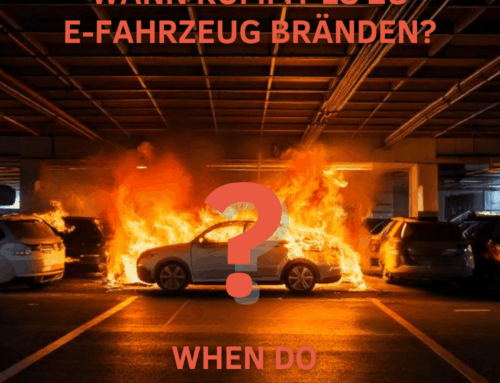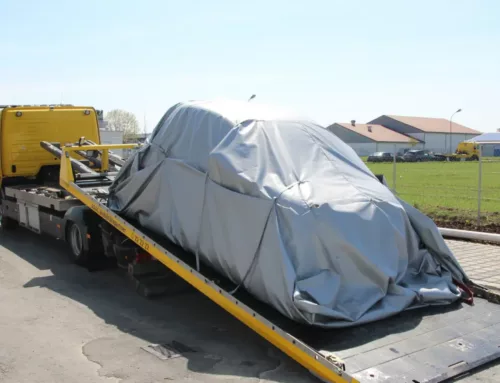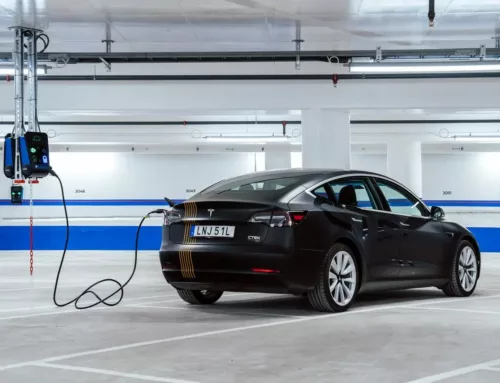
Electromobility is growing rapidly worldwide, but this development is also creating new challenges in fire protection. fire blankets play a decisive role in the containment of fires in electric vehicles. DIN SPEC 91489 defines specific requirements for these blankets for the first time.
In this article, you will find out why DIN SPEC 91489 is important, what requirements it defines and how fire blankets prove themselves in use.
Table of contents
Why is DIN SPEC 91489 necessary?
Fires in electric vehicles are particularly challenging. The high-voltage batteries can re-ignite over a period of hours or days, which often pushes conventional extinguishing methods to their limits.
fire blankets are not designed to extinguish a battery fire, but to control it and prevent it from spreading. They reduce smoke development, limit the spread of heat and prevent the fire from spreading to surrounding objects.
As there were previously no uniform specifications for the quality and functionality of fire blankets , DIN SPEC 91489 was developed. For the first time, it creates a clear standard for the use of these blankets in electric vehicles. DIN SPEC 91489 was developed on the initiative of representatives from the automotive industry, the insurance industry, (testing) institutes, fire protection experts and manufacturers of fire blankets, including Friedhelm Schwender, founder of VLITEX.
What does DIN SPEC 91489 regulate?
DIN SPEC 91489 specifies the technical and safety requirements that fire blankets must meet in order to be used effectively in electric vehicle fires.
Core requirements of DIN SPEC 91489
Thermal resistance:
- The fire blanket must withstand temperatures of up to 1,000°C for 23 minutes.
- The blanket must not show any holes or seam failure during the test.
Mechanical stability:
- High tear and cut resistance to ensure safe handling.
- Minimum requirement for the cut protection level: ≥2N according to DIN EN ISO 13997.
- For increased protection: cut resistance ≥15N.
Protection against electric shock:
- The ceiling must be designed in such a way that there is no risk of electrostatic charging.
Chemical resistance:
- Contact with fuels, oils or extinguishing agents must not impair the function of the ceiling.
Labeling and manufacturer information:
- Each ceiling must be permanently marked with:
- Manufacturer information
- Model and type number
- Production date
- Serial number for traceability
- Clear instructions on handling, storage and disposal must also be included.
- Each ceiling must be permanently marked with:
Storage & transportation:
- It must be possible to stow the fire blanket in a dust and water-protected container (min. IP65).
- Easy removal and repackaging after use must be guaranteed.
How are fire blankets tested?
To ensure that fire blankets meet the requirements of DIN SPEC 91489, they have to pass extensive practical tests.
The test procedures include:
- Temperature tests: Direct flame treatment of the ceiling for 23 minutes at temperatures of up to 1,000°C.
- Mechanical tests: Load test of the straps with a weight of up to 125 kg.
- Cut resistance tests: Test in accordance with DIN EN ISO 13997 to guarantee that the ceiling is resistant to mechanical damage.
- Electrostatic tests: Ensure that there is no uncontrolled electrical charge that could cause ignition.
A fire blanket can only be certified in accordance with DIN SPEC 91489 if all these tests are passed successfully.
Why is DIN SPEC 91489 important for fire departments and companies?
For fire departments, towing services, workshops and parking garage operators, DIN SPEC 91489 provides a clear guide to which fire blankets are really suitable for use.
Advantages for fire departments:
✅ Standardized blankets facilitate safe and rapid deployment.
✅ Reduced smoke development ensures better visibility.
✅ Rapid application minimizes the risk to emergency services.
Advantages for towing companies & workshops:
✅ Safe storage of e-vehicles involved in accidents in quarantine areas.
✅ Less space required due to secure cover instead of large safety distances.
✅ Clear guidelines for insurance companies and authorities.
Benefits for multi-storey & underground parking lots:
✅ Minimize the risk of fire in enclosed spaces.
✅ Meet safety requirements for e-vehicle parking spaces.
An important step for safety in the age of e-mobility
With the introduction of DIN SPEC 91489, a binding standard for fire blankets in electric vehicles has been created for the first time.
- For fire departments and companies, this means greater safety and clear guidelines for emergencies.
- The standard provides manufacturers with a uniform quality specification.
- For e-vehicle owners, it is a further step towards making the infrastructure safer.
Find out more about DIN SPEC 91489 and suitable fire blankets here: VLITEX fire blankets for electric vehicles
External source for DIN SPEC 91489: DIN Media - Official overview of standards









